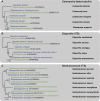One fungus, one name promotes progressive plant pathology
- PMID: 22146077
- PMCID: PMC6638803
- DOI: 10.1111/j.1364-3703.2011.00768.x
One fungus, one name promotes progressive plant pathology
Abstract
The robust and reliable identification of fungi underpins virtually every element of plant pathology, from disease diagnosis to studies of biology, management/control, quarantine and, even more recently, comparative genomics. Most plant diseases are caused by fungi, typically pleomorphic organisms, for which the taxonomy and, in particular, a dual nomenclature system have frustrated and confused practitioners of plant pathology. The emergence of DNA sequencing has revealed cryptic taxa and revolutionized our understanding of relationships in the fungi. The impacts on plant pathology at every level are already immense and will continue to grow rapidly as new DNA sequencing technologies continue to emerge. DNA sequence comparisons, used to resolve a dual nomenclature problem for the first time only 19 years ago, have made it possible to approach a natural classification for the fungi and to abandon the confusing dual nomenclature system. The journey to a one fungus, one name taxonomic reality has been long and arduous, but its time has come. This will inevitably have a positive impact on plant pathology, plant pathologists and future students of this hugely important discipline on which the world depends for food security and plant health in general. This contemporary review highlights the problems of a dual nomenclature, especially its impact on plant pathogenic fungi, and charts the road to a one fungus, one name system that is rapidly drawing near.
© 2011 The Authors. Molecular Plant Pathology © 2011 BSPP and Blackwell Publishing Ltd.
Figures



Similar articles
-
Identifying and naming plant-pathogenic fungi: past, present, and future.Annu Rev Phytopathol. 2015;53:247-67. doi: 10.1146/annurev-phyto-080614-120245. Epub 2015 May 27. Annu Rev Phytopathol. 2015. PMID: 26047568 Review.
-
The impacts of the discontinuation of dual nomenclature of pleomorphic fungi: the trivial facts, problems, and strategies.IMA Fungus. 2012 Jun;3(1):81-6. doi: 10.5598/imafungus.2012.03.01.08. Epub 2012 Jun 21. IMA Fungus. 2012. PMID: 23155502 Free PMC article.
-
Names of Phytopathogenic Fungi: A Practical Guide.Phytopathology. 2021 Sep;111(9):1500-1508. doi: 10.1094/PHYTO-11-20-0512-PER. Epub 2021 Oct 25. Phytopathology. 2021. PMID: 33487022
-
Hitchhiker's guide to multi-dimensional plant pathology.New Phytol. 2015 Feb;205(3):1028-33. doi: 10.1111/nph.12946. Epub 2014 Jul 24. New Phytol. 2015. PMID: 25729800 Review.
-
One Fungus = One Name: DNA and fungal nomenclature twenty years after PCR.IMA Fungus. 2011 Dec;2(2):113-20. doi: 10.5598/imafungus.2011.02.02.01. Epub 2011 Jul 12. IMA Fungus. 2011. PMID: 22679595 Free PMC article.
Cited by
-
Sporocadaceae, a family of coelomycetous fungi with appendage-bearing conidia.Stud Mycol. 2019 Mar;92:287-415. doi: 10.1016/j.simyco.2018.11.001. Epub 2018 Nov 17. Stud Mycol. 2019. PMID: 30584265 Free PMC article.
-
MycoBank gearing up for new horizons.IMA Fungus. 2013 Dec;4(2):371-9. doi: 10.5598/imafungus.2013.04.02.16. Epub 2013 Dec 17. IMA Fungus. 2013. PMID: 24563843 Free PMC article.
-
Exploring fungal mega-diversity: Pseudocercospora from Brazil.Persoonia. 2016 Dec;37:142-172. doi: 10.3767/003158516X691078. Epub 2016 Feb 12. Persoonia. 2016. PMID: 28232763 Free PMC article.
-
A phylogenetic re-evaluation of Arthrinium.IMA Fungus. 2013 Jul;4(1):133-54. doi: 10.5598/imafungus.2013.04.01.13. Epub 2013 Jun 24. IMA Fungus. 2013. PMID: 23898419 Free PMC article.
-
Fast and reliable molecular methods to detect fungal pathogens in woody plants.Appl Microbiol Biotechnol. 2020 Mar;104(6):2453-2468. doi: 10.1007/s00253-020-10395-4. Epub 2020 Jan 31. Appl Microbiol Biotechnol. 2020. PMID: 32006049 Free PMC article. Review.
References
-
- Alves, A. , Crous, P.W. , Correia, A. and Phillips, A.J.L. (2008) Morphological and molecular data reveal cryptic speciation in Lasiodiplodia theobromae . Fungal Divers. 28, 1–13.
-
- Bensch, K. , Groenewald, J.Z. , Dijksterhuis, J. , Starink‐Willemse, M. , Andersen, B. , Summerell, B.A. , Shin, H.‐D. , Dugan, F.M. , Schroers, H.‐J. , Braun, U. and Crous, P. (2010) Species and ecological diversity within the Cladosporium cladosporioides complex (Davidiellaceae, Capnodiales). Stud. Mycol. 67, 1–94. - PMC - PubMed
-
- Berbee, M.L. and Taylor, J.W. (1992) 18S ribosomal RNA gene sequence characters place the pathogen Sporothrix schenckii in the genus Ophiostoma . Exp. Mycol. 16, 87–91.
-
- Briquet, J. (1905) Texte synoptique des documents destinés à servir de base aux débats du Congrès International de Nomenclature Botanique de Vienne 1905. Commission Internationale de Nomenclature Botanique. Berlin: Friedländer.
Publication types
MeSH terms
LinkOut - more resources
Full Text Sources
Medical
Molecular Biology Databases

